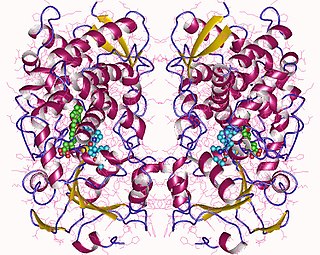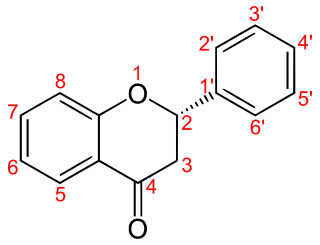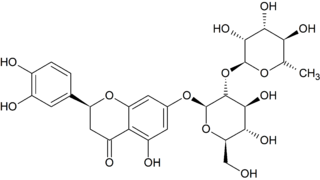
Flavonoids are a class of polyphenolic secondary metabolites found in plants, and thus commonly consumed in the diets of humans.

Polyphenols are a large family of naturally occurring phenols. They are abundant in plants and structurally diverse. Polyphenols include phenolic acids, flavonoids, tannic acid, and ellagitannin, some of which have been used historically as dyes and for tanning garments.

Cytochrome P450 3A4 is an important enzyme in the body, mainly found in the liver and in the intestine, which in humans is encoded by CYP3A4 gene. It oxidizes small foreign organic molecules (xenobiotics), such as toxins or drugs, so that they can be removed from the body. It is highly homologous to CYP3A5, another important CYP3A enzyme.

Quercetin is a plant flavonol from the flavonoid group of polyphenols. It is found in many fruits, vegetables, leaves, seeds, and grains; capers, red onions, and kale are common foods containing appreciable amounts of it. It has a bitter flavor and is used as an ingredient in dietary supplements, beverages, and foods.

Naringenin is a flavanone from the flavonoid group of polyphenols. It is commonly found in citrus fruits, especially as the predominant flavonone in grapefruit.

Rutin is the glycoside combining the flavonol quercetin and the disaccharide rutinose. It is a flavonoid glycoside found in a wide variety of plants, including citrus.

Naringin is a flavanone-7-O-glycoside between the flavanone naringenin and the disaccharide neohesperidose. The flavonoid naringin occurs naturally in citrus fruits, especially in grapefruit, where naringin is responsible for the fruit's bitter taste. In commercial grapefruit juice production, the enzyme naringinase can be used to remove the bitterness (debittering) created by naringin. In humans naringin is metabolized to the aglycone naringenin by naringinase present in the gut.

Hesperidin is a flavanone glycoside found in citrus fruits. Its aglycone is hesperetin. Its name is derived from the word "hesperidium", for fruit produced by citrus trees.

Apigenin (4′,5,7-trihydroxyflavone), found in many plants, is a natural product belonging to the flavone class that is the aglycone of several naturally occurring glycosides. It is a yellow crystalline solid that has been used to dye wool.

Cytochrome P450, family 1, subfamily A, polypeptide 1 is a protein that in humans is encoded by the CYP1A1 gene. The protein is a member of the cytochrome P450 superfamily of enzymes.

The flavanones, a type of flavonoids, are various aromatic, colorless ketones derived from flavone that often occur in plants as glycosides.

Transient receptor potential cation channel subfamily M member 3 is a protein that in humans is encoded by the TRPM3 gene.

Isosakuranetin, an O-methylated flavonoid, is the 4'-methoxy derivative of naringenin, a flavanone. Didymin, a disaccharide of isosakuranetin, occur e.g. in sweet orange, blood orange and mandarin. Isosakuranetin is a potent inhibitor of TRPM3 channels.
The O-methylated flavonoids or methoxyflavonoids are flavonoids with methylations on hydroxyl groups. O-methylation has an effect on the solubility of flavonoids.
Daflon is an oral micronized purified phlebotonic flavonoid fraction containing 90% diosmin and 10% hesperidin. It is manufactured by Laboratoires Servier and often used to treat or manage disorders of the blood vessels. Flavonoids are a type of phytochemical that have been associated with various effects on human health and are a component of many different pharmaceutical, nutraceutical, and cosmetic preparations. Diosmin is a flavone glycoside that is derived from hesperidin. Hesperidin is a flavone that is extracted from citrus fruits.

Neoeriocitrin is a 7-O-glycoside of the flavanone eriodictyol and the disaccharide neohesperidose . Note that the 'neo' in the name in this case does not refer to the position of the B-ring, but refer to the glycosyl moiety.

Melitidin is a flavanone glycoside. Melitidin was discovered in bergamot orange juice and exhibits statin-like properties in preclinical research.

Neohesperidin is a flavanone glycoside found in citrus fruits. It is the 7-O-neohesperidose derivative of hesperetin, which in turn is the 4'-methoxy derivative of eriodictyol. Neohesperidin dihydrochalcone has an intense sweet taste, and is listed as a generally recognized as safe flavour enhancer by the Flavor and Extract Manufacturers Association.

Ononetin is a natural product from the deoxybenzoin group, which is found in the Russian traditional medicine plant Ononis spinosa. It acts as an inhibitor of the transient receptor potential ion channel TRPM3 and has analgesic effects in animal studies, as well as being used for research into the role of TRPM3 in the immune system dysfunction associated with chronic fatigue syndrome.

4'-Hydroxyflavanone is a naturally occurring monohydroxybenzoic acid and a member of the 4'-hydroxyflavanones family. It is white to pale orange in color and generally soluble in organic solvents such as chloroform and ethanol, but insoluble with water. 4'-Hydroxyflavanone is a naturally occurring product with cosmetic and potential clinical applications that is found in plants such as carnations.



















